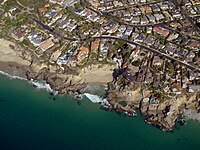
Photo from wikipedia
Abstract This study utilizes close range photogrammetry (CRP) to measure the texture of asphalt pavement surfaces with a view to explaining the variation of friction measurements obtained using a GripTester.… Click to show full abstract
Abstract This study utilizes close range photogrammetry (CRP) to measure the texture of asphalt pavement surfaces with a view to explaining the variation of friction measurements obtained using a GripTester. A handheld camera was employed to capture images at different locations on both lanes of pavement sections using a scale rule for identification of control points. Proprietary software were employed for creation and analysis of 3D models from the images to determine pavement surface texture parameters. Different scenarios were considered including pavement surface analysis before and after filtering for micro- and macro-texture separation. Thresholding with respect to height to analyze the top 1–2 mm of the surface was also considered. Texture parameters were then related to friction measured at the image capture locations. The lane with higher friction values generally showed higher individual texture parameters across different scenarios. However, meaningful texture-friction correlations along the lanes were only obtained with the top 2 mm of the surface. Stepwise regression indicated that the density of peaks (Spd) and the peak material volume (Vmp) best correlate (R2 = 0.75–0.76) with friction, but the Spd is more influential. These parameters can be used as indicators of pavement surface friction during its service life.
Journal Title: Construction and Building Materials
Year Published: 2018
Link to full text (if available)
Share on Social Media: Sign Up to like & get
recommendations!